Toward2ndEd_SoundFiles.html
Toward2ndEd_SoundFiles.html
Back to home page
Back to "Occasional Papers"
This page contains the sound files and respective texts discussed in the second, expanded and updated edition of Reuven Tsur's book Toward a Theory of Cognitive Poetics.
Chapter 3
Constructing a Stable World
Diana Deutsch most dramatically demonstrated the importance of hypotheses in music perception. She took a well-known tune and distributed its notes haphazardly among three different octaves, retaining the correct notenames (C, D, E and so on). "Listen to the tune and try to guess its name. The task is surprisingly difficult!"
"The [second tune] is identical to the first one, except that now the tones are all in the same octave. You should have no difficulty in recognizing this tune. Once you know what to listen for, try the pattern of the [first tune] again—you might find it much easier to follow". In terms of the present discusssion, the second tune provides a hypothesis that organizes the first pattern into a coherent whole. By the same token, this experiment demonstrates the gestalt principle of Proximity. The nearer the notes to one another (in this case in pitch), it is easier to organize them into a coherent perceptual pattern.
Chapter 6
Metre and Rhythm
The Darwin-Donovan Experiment
In a series of brilliant experiments, C. I. Darwin and A. Donovan of Sussex University (1979, two papers and demo tape) have shown that in sentences like "He turned up by ten talking of terrorism", subjects tend to hear equal time intervals between the /t/ sounds in the stressed syllables, although they are objectively unequal. However, when they listen to a sequence of mechanical clicks that are acoustically similar, the same time intervals as between the /t/ sounds are perceived, as they should be, as unequal. When, finally, the clicks and the /t/ sounds in the text are carefully synchronized and sounded simultaneously, the intervals between the /t/ sounds are perceived as equal, whereas the intervals between the clicks are perceived as unequal. The tendency for perceptual isochrony works within intonation contours, but not across contour boundaries.
Listen to the sentence "He turned up by ten talking of terrorism".
Listen to the mechanical clicks arranged by listeners to reflect the intervals between the /t/ sounds as they heard them.
Listen to the mechanical clicks that reflect the exact, measured intervals between the /t/ sounds.
Listen to the sentence "He turned up by ten talking of terrorism" and the mechanical clicks carefully synchronized with the /t/ sounds.
33. Bright Star! would I were steadfast as thou art!

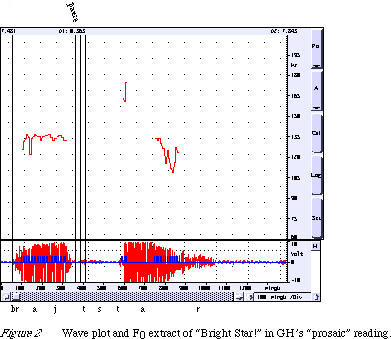
Listen to GH's readings of Quote 22.
Chapter 7
Delivery Style and Listener Response —An Empirical Study
1. Sylvan historian, who canst thus express
A flowery tale more sweetly than our rhyme...
In Excerpt 1 syntax demands continuation after express; versification demands discontinuation. The majority of listeners made the judgment that Hodge offers a rhythmical solution to the problem, by suggesting continuation and discontinuation at the same time at the end of the word express, whereas in Sheen's reading A at the beginning of the next line is irritatingly continuous with express. There is no measurable pause in either of the readings between the two words; and this takes care of syntactic continuity. In the manipulated version I tried to reproduce Hodge's effect of discontinuation in Sheen's reading. Using the application SoundScope, I lengthened the word-final /s/; and copied Hodge's glottal stop from before A, pasting it into Sheen's reading. In addition, Sheen overstresses our, violating the iambic cadence of the line. In manipulated version 2 I used the application Audacity to reduce the tempo of the word rhyme, lengthening it without affecting pitch, in an attempt to make it break rhythmically even with the emphatic stress on our.
Listen to two actors' readings of excerpt 1.

Listen to Sheen's readings of quote 1.



Listen to Gielgud's first reading (Gielgud 1).
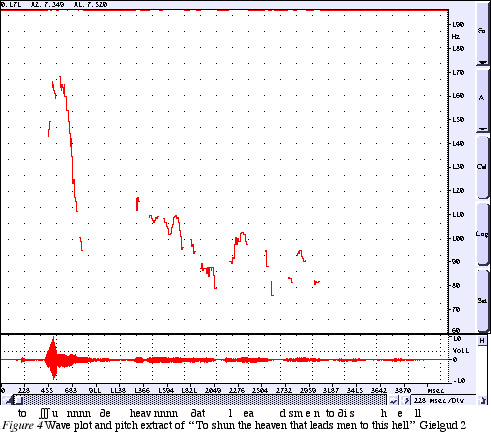
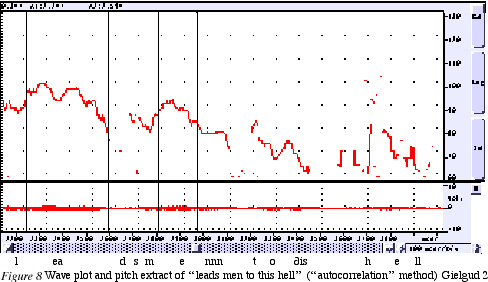
Listen to Gielgud's second reading (Gielgud 2).

Listen to The Marlowe Society's reading
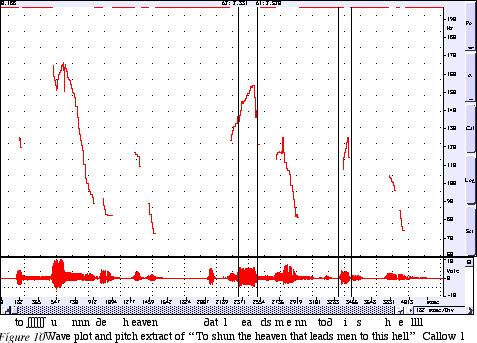
Listen to Callow's genuine reading (Callow 1).
In Callow's recording we encounter serious trouble with the phrase "leads men": "leads" (in a strong position) bears stronger stress than "men" (in a weak position). Likewise, "this" (in a weak position) bears stronger stress than "hell" (in a strong position). In the former phrase linguistic stress suffers, in the latter -- metric prominence. In both phrases, the intonation peak is lower on the rightmost member, the noun. I have tried to lengthen electronically these nouns and see whether duration would restore rhythmicality, by "breaking even" with the preceding higher pitch. I copied minute parts of the speech sounds and pasted them again and again. The lengthening of the vowel in "men" generated some emotional distortion: one of my informants commented that it "provides a false emotional emphasis to the line".
Listen to Callow's doctored reading (Callow 2).
Fortunately enough, there was a delay between the completion of this article and its publication, during which I had access to the speech analyser "Praat". This application offers features for manipulating pitch and duration, yielding relatively natural results. This may provide less "false emotional emphasis" for the manipulated words in Callow's reading. I have manipulated only the duration, not the pitch, of the words "men" and "hell", so as to leave all other things equal. Notwithstanding this, the change of speed did affect the voice quality of these words to some extent.

Listen online to a version produced on a combination of two speech analysers, Praat and SoundScope (Callow 3).
Listen online to yet another version produced on the sound processor Audacity (Callow 4).

Listen online to
"bright", "brighten", and the stop release excised from "bright
", as read in the Merriam–Webster's Collegiate Dictionary (Audio Edition) .
Listen to the words "leads men" in the four recordings Gielgud 1, Gielgud 2, The Marlowe Society, and Callow (in this order).
Listen to the tokens of "leads men" excised from Callow 1, Callow 2 and Callow 3.
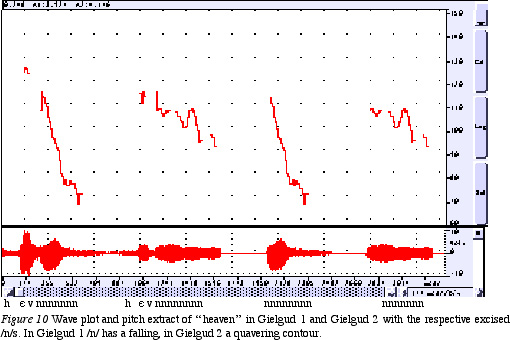
Listen to "heaven" in Gielgud 1 and Gielgud 2 with the respective excised /n/s. .
Chapter 8
Expressiveness and Musicality of Speech Sounds
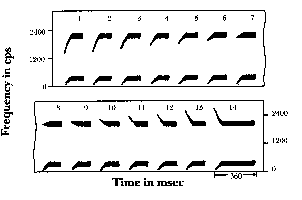
Figure 2 Hand-painted spectrograms of the syllables
ba, da, ga.
The ba--da--ga pitch continuum of F2 is
divided into 14 steps instead of three.
The two parallel
regions of black indicate regions of energy concentration,
F1 and F2.
Notice that the onset frequency of F2 of
da is higher than that of ba;
and the onset frequency
of F2 of ga is higher than that of da.
I wish to illustrate these two modes of listening through two series of sound stimuli from an unpublished demo tape by Terry Halwes. Listen to the series in figure 2, and see whether you hear the change from [ba] to [da], from [da] to [ga] occur suddenly.
Let us isolate the second formant transition, that piece of sound which differs across the series, and listen to just those sounds alone.
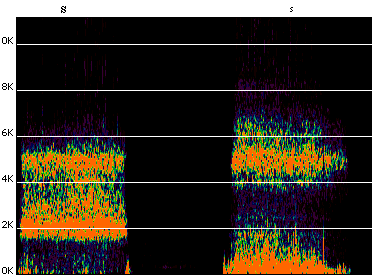
Figure 3 Sonograms of [S] and [s], representing the
first and second formant,
and indicating why [s] is
somehow "higher".
(S represents the initial consonant of shoe; s the initial consonant of sue)
Listen to the Europen cuckoo's call and the phonetic i-a-u vowels. The cuckoo says neither [k] nor [u]. But the formant structure of the cuckoo's call is nearest to that of the [u].
The voiceless plosive [k] indicates an abrupt onset rather than the specific sound heard (which most resembles [h]). The minor third interval cannot be conveyed by the lexicon (not even in Chinese, which does have segmental tones). Signs of one semiotic system cannot be exactly translated to another semiotic system. The accuracy of translation is determined by whether the nearest options of the target system are chosen. Chinese transcribes the cuckoo's call as [puku] with a rising-falling tone inflection on the second syllable (that does not resemble the cuckoo's minor-third interval); and, obviously, it has recourse to another voiceless plosive, [p], rather than to [h].

Figure 4 The upper window presents the the first and
second formant of the cuckoo's song
and of the phonetic
vowels i-a-u; the lower window presents their waveform.

Figure 5 The upper windows present the pitch contours
of the cuckoo's song
and of the phonetic vowels i-a-u
spoken by a male;
the lower windows present their
waveform.
Listen to the cuckoo's call translated into another semiotic system, the symphony orchestra, in the fourth movement of Leopold Mozart's "Toy Symphony". Not as in the phonetic transcription, here the minor third interval is preserved, the abrupt onset is directly conveyed, but the [u] quality can be preserved less or more—according to the sound colour of the wind instrument on which it is played. In the present instance it has not been preserved.
Listen to just the sound imitation of the cuckoo's call in the "Toy Symphony".

The lower window presents the pitch extract
from the sound imitation of the cuckoo's call;
the upper two windows present the stereo wave form.

Figure 6 Spectrograms of the syllables ba, da, ga, in
natural speech.
Back to home page
Back to "Occasional Papers"

















